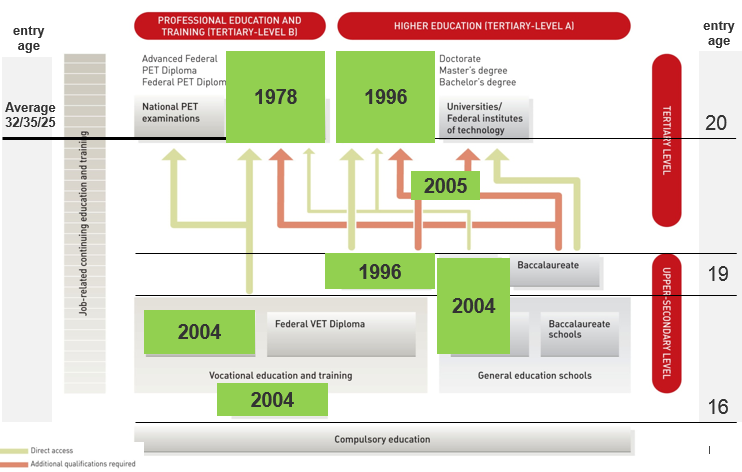Entry 10 – Building Permeability: Modern Reforms in Switzerland
The Swiss system of vocational education and training (VET) is famous for its effectiveness and permeability. Switzerland enjoys low youth unemployment, global competitiveness, and innovation. While VET isn’t the only factor at play, Swiss business leaders and politicians point to the strong VET system in Switzerland as a contributing factor again and again. How did the Swiss system get to where it is today? CEMETS is a reform lab, so let’s talk about reforms at home.
By Katie Caves
external page Based on Egg & Renold (2014)- written in Spanish
The Swiss system of vocational education and training (VET) is famous for its effectiveness at bringing young people into the labor market and its permeability between levels and types of education and training. Switzerland enjoys external page low youth unemployment, which is especially valuable after the economic crisis that still leaves many European countries with alarmingly high rates of youth joblessness. Switzerland is also external page top in global competitiveness and external page innovation. While VET isn’t the only factor at play, Swiss business leaders and politicians point to the strong VET system in Switzerland as a contributing factor again and again.
While it’s easy to assume that the system arose out of centuries of history dating back to medieval guilds, that point of view ignores the hard work and reform that has brought Switzerland to the modern system it has today. Switzerland’s guilds were abolished by a free trade law in 1874, effectively ending the old apprenticeship system. Industrial-revolution-era factories arose in their place and reduced the importance of skilled workers for a while, but employers quickly noticed that quality and productivity suffered without well-educated workers.
In the second half of the 19th century, employers formed professional associations and began developing the employer-led system of dual VET that exists today. Associations developed VET and professional education and training (PET) examinations, organized theoretical classes in schools, and taught practical skills in host companies. Quality, productivity, and economic growth improved, so the Swiss government decided to support the system by paying for schools. Cantons began to enact laws and enforce norms that protected the rights of trainees and quality of training.
In 1908, legal authority over VET was moved to the federal level in the Swiss constitution. The first VET Act was passed in 1930, establishing a nationwide legal framework for VET. Professional associations had been key to drafting the law, but its scope was limited to crafts, industry, transportation, and trade. After the two world wars, participation in VET had increased enough that it was the default educational pathway for young people.
Increasing participation and technological change led to a new law in 1963, which included more federal support for VET, introduced training requirements for each occupation, and required more transferrable content in the school curriculum. This was followed by a third VET law in 1978, which introduced PET—higher education for VET—for the first time. The 1978 law also introduced the third training place, charged with teaching industry-wide skills through inter-company courses and training centers.
The next wave of reforms began to implement permeability and new programs that make the Swiss system the global leader it is today. In 1994, the Federal Vocational Baccalaureate (FVB) was introduced, which enabled young people to prepare for higher education during or soon after an apprenticeship. Universities of Applied Sciences were established in 1996, and any apprenticeship graduate with a FVB was eligible to attend. A major 1999 constitutional reform in response to the “apprenticeship crisis” of the mid-1990s brought all non-University professions under the umbrella of VET and PET, including the health, social, and arts sectors.
Figure 1: Key changes to the Swiss VET & PET system over time
The fourth and current VET Act was enacted in 2002. Its main change was a new method for developing occupational framework curricula, which must now include “standards of excellence” for all three learning locations. The new curricula improved effectiveness across all three learning locations and define qualification criteria, grading processes, and exams. They include not only technical and vocational skills, but also methodological, social, and personal skills—soft skills that are highly in demand on the labor market. Finally, the 2002 VET Act set aside resources for research and innovation projects in VET.
By the mid-2000s, the only missing links in the system were clear pathways for apprenticeship graduates to enter traditional universities and options for those who struggled to choose or succeed in upper-secondary programs. Bridge-year courses for young people who couldn’t decide or find the right apprenticeship were established in 2004, along with a two-year certificate program for young people who struggled to succeed in apprenticeships. In 2005, the University Aptitude Test was created so young people with an FVB could move straight into traditional universities if they passed. With those reforms, the Swiss system became fully permeable.
Today’s VET system makes it possible for people of every age, from any Canton in Switzerland, and from all public and private institutions to achieve high-quality education that gives them access to the labor market and further education and training options throughout the country. The system is under constant improvement, and every occupational curriculum is updated regularly in an employer-led process that keeps qualifications up to date with changing labor market needs. Although the Swiss system still faces challenges and will continue to improve, the changes since its inception and especially over the last three decades are what make it the best in the world. Young people who start in any program at age 15 have clear pathways to any endpoint in the education system and VET students know their qualifications will help them start careers.
